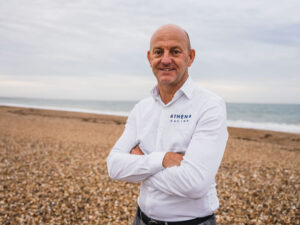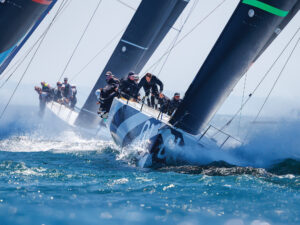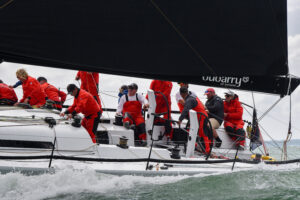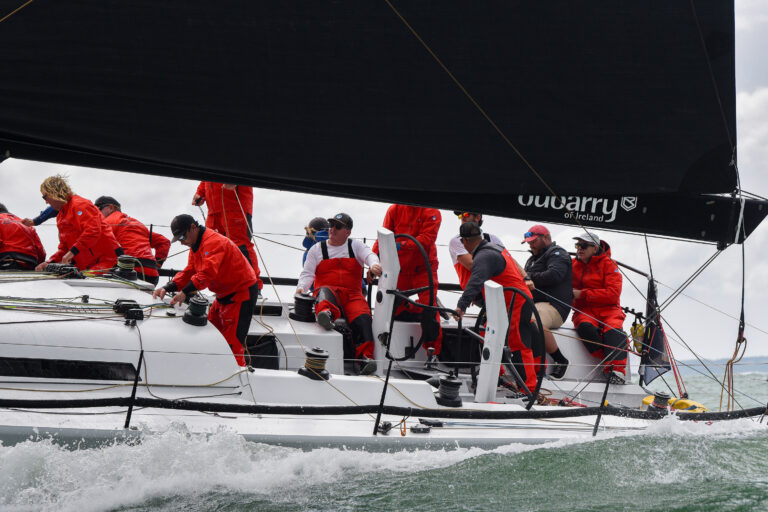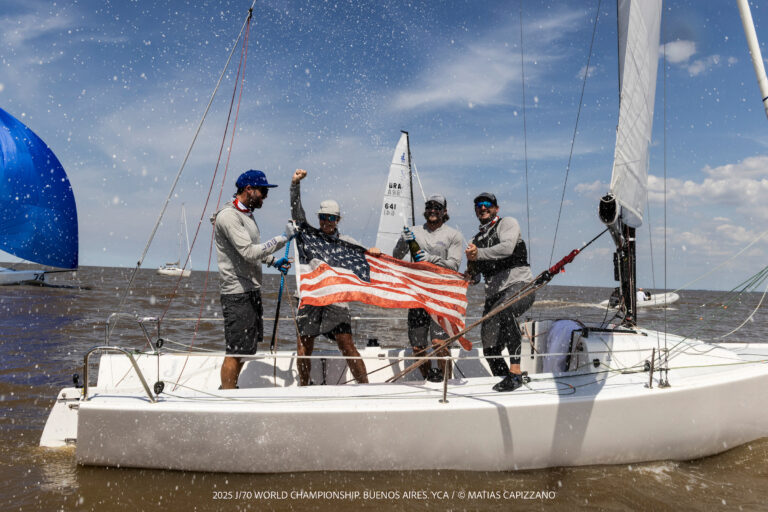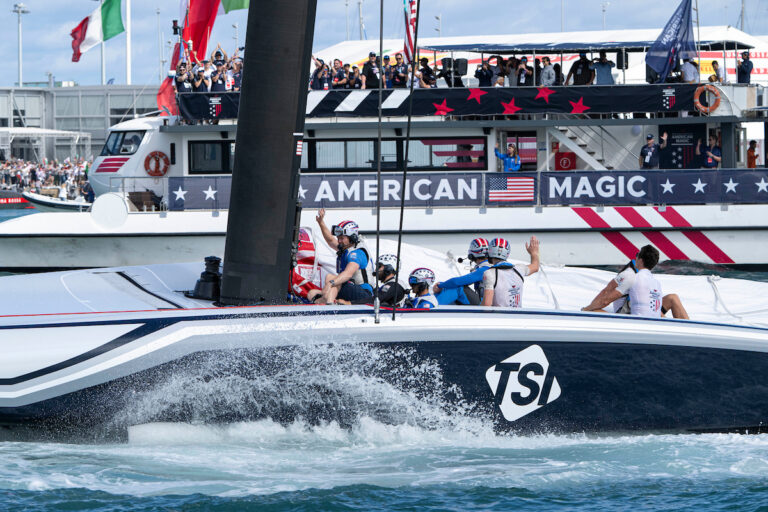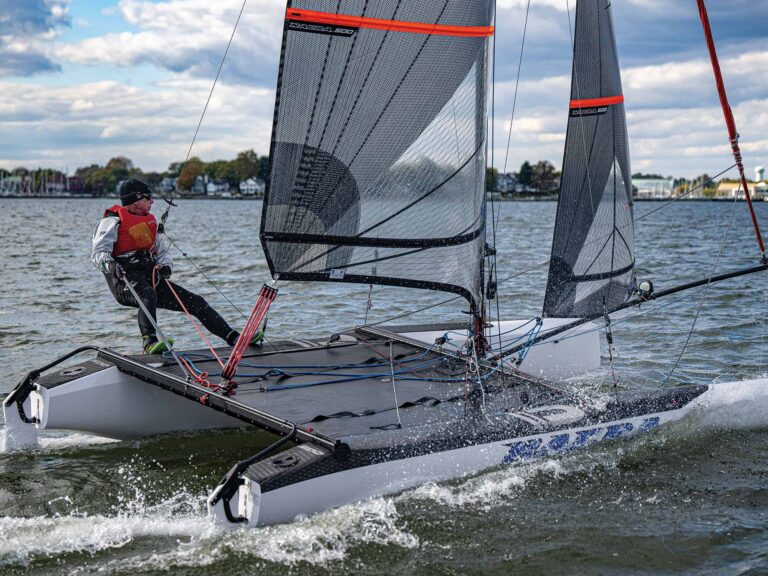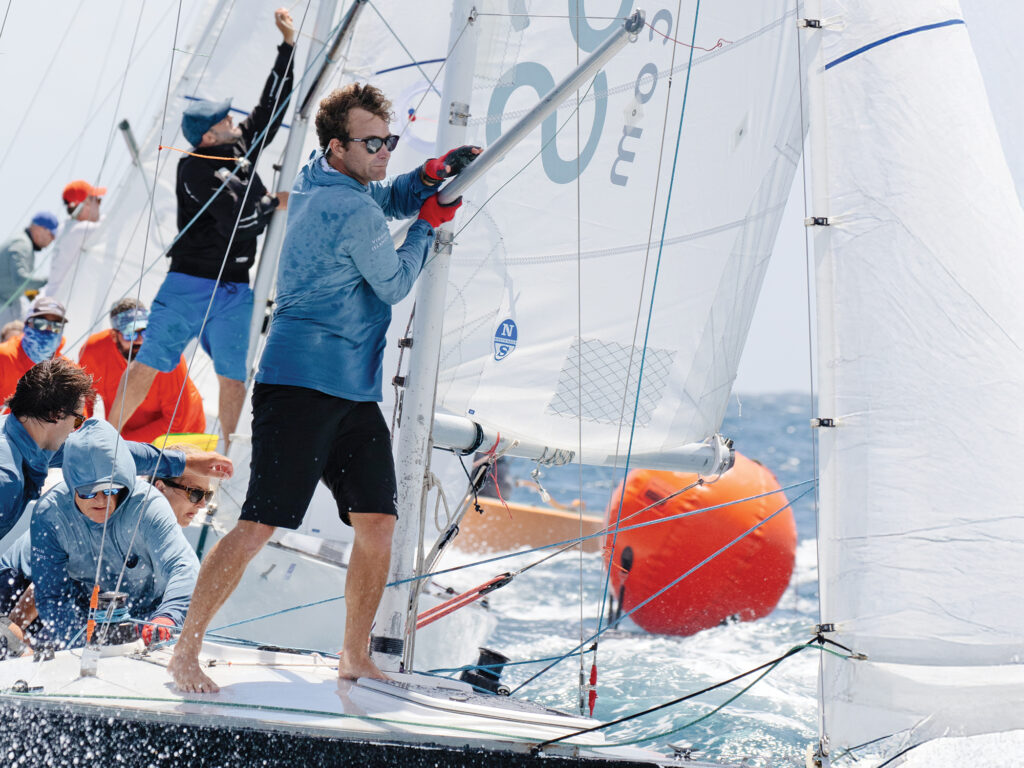
Nothing else matters except beating that one boat across the finish line.
Which is why I’m maniacally trimming the sail even though it hurts like hell. Every time the winged-out jib folds back onto itself and refills with a violent snap, zingers of pain shoot into my right shoulder. It might be carnage to my rotator cuff, but screw it. I don’t care. Over my shoulder, straight off to starboard 100 feet away, is the pink boat with a crew in matching pink shirts. The two of us are battling it out at the tail end of the 21-boat fleet, as we have been for the past three days. There’s always one boat in every regatta that seems magnetic, right? Voila is that one, and right now we’re mathematically guaranteed to beat them in the regatta. This race is for all the karma marbles.
We’re neck-and-neck in the 14th race of the best-kept secret in all of one-design racing. While the two of us are hand-to-hand for our respective points and our dignity, the leaders are already halfway back to Cowpet Bay and the chillaxed St. Thomas YC, where the Cruzan rum and the all-you-can-eat buffet awaits. Here at the back of the fleet on the sand-colored Stinger, my teammates and I are broken, but we’re not quitting.
With me is our skipper Ian Scott, the finest gentleman yachtsman anyone could ever sail with. I’ve been his bowman on the J/24 Crack O’ Noon for exactly 37 years. Practically cradle to grave. On jib and spinnaker trim is Herb McCormick, who’s been cross-sheeting Crack O’s genoa sheets for more than 40 years. The two of them are lifelong Aquidneck Island mates. They’re brothers, as far I’m concerned. Both raised me to be the sailor I am. Which I guess makes them my sailing fathers.
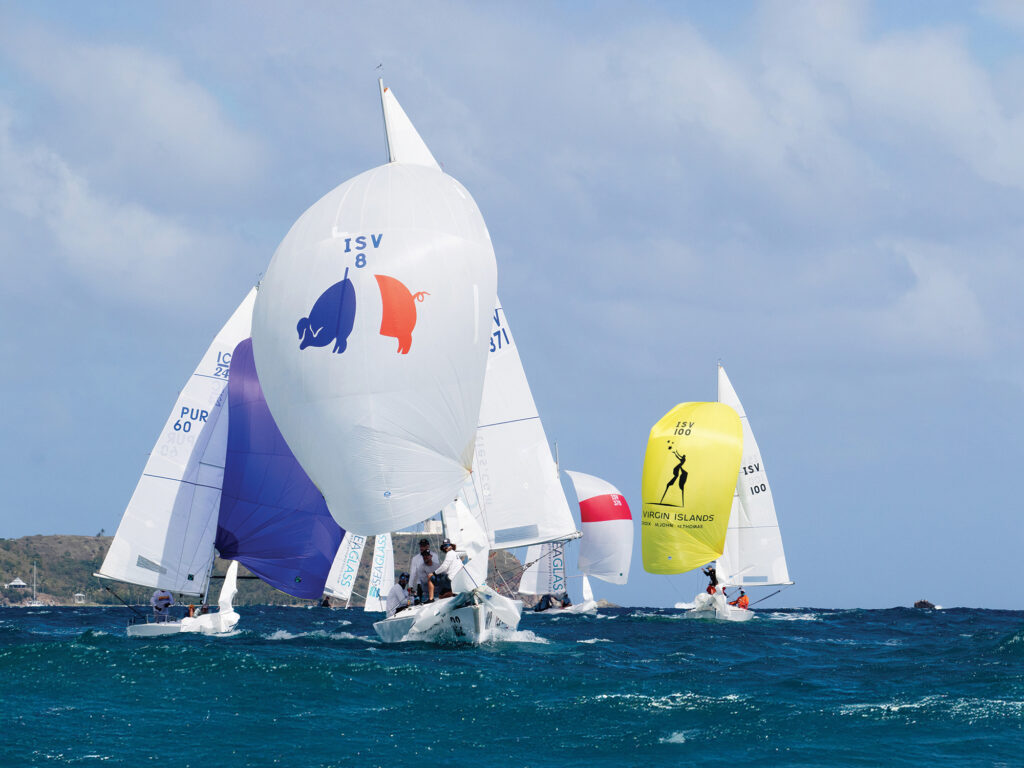
That said, I’ve never sailed or raced with my own father, even though he’s the one who cast me off into the sport as a wee lad. That is something I regret, which is why I’ve recruited my 21-year-old son, Tim. He never liked sailing when he was young, and I never pushed it. Given his towering height, basketball naturally became his thing. Before we step foot on Stinger for a day of practice, he doesn’t know a vang from tang, a guy from a twing, or a tack from a jibe, but after a few practice laps, he’s plenty up to speed.
Show-Up-And-Race
So, that’s the four of us: Ian, Herb, Dave and Tim. Team Crack O’ Noon, checking in from Newport, Rhode Island’s J/24 Fleet 50, where the legends and Read brothers once ruled. We’re here for spring training—because we said we would be over too many beers seven months earlier. Our boat for this exercise is the aforementioned Stinger. It’s one of a dozen IC24s that are owned by the St. Thomas YC and used extensively for its adult racing, member gunkholing and the annual St. Thomas International Regatta, which everyone simply refers to as STIR. The regatta, which is always held in March when the trade winds reliably blow, is the club’s marquee event. And the marquee fleet is the IC24, which is essentially a modified J/24. Think of it as a mashed J/24, J/22 and J/80. There’s no genoa to rake across the rig. Just a happy little jib, a symmetric spinnaker, and legs inboard at all times.
The IC24 is a brilliant concept conceived by St. Thomas local Chris Rosenberg. As the class story goes, after Hurricane Marilyn wiped everything the club had, Rosenberg had the wisdom to reimagine and remake a J/24 as a comfortable, five-person, user-friendly interclub keelboat.
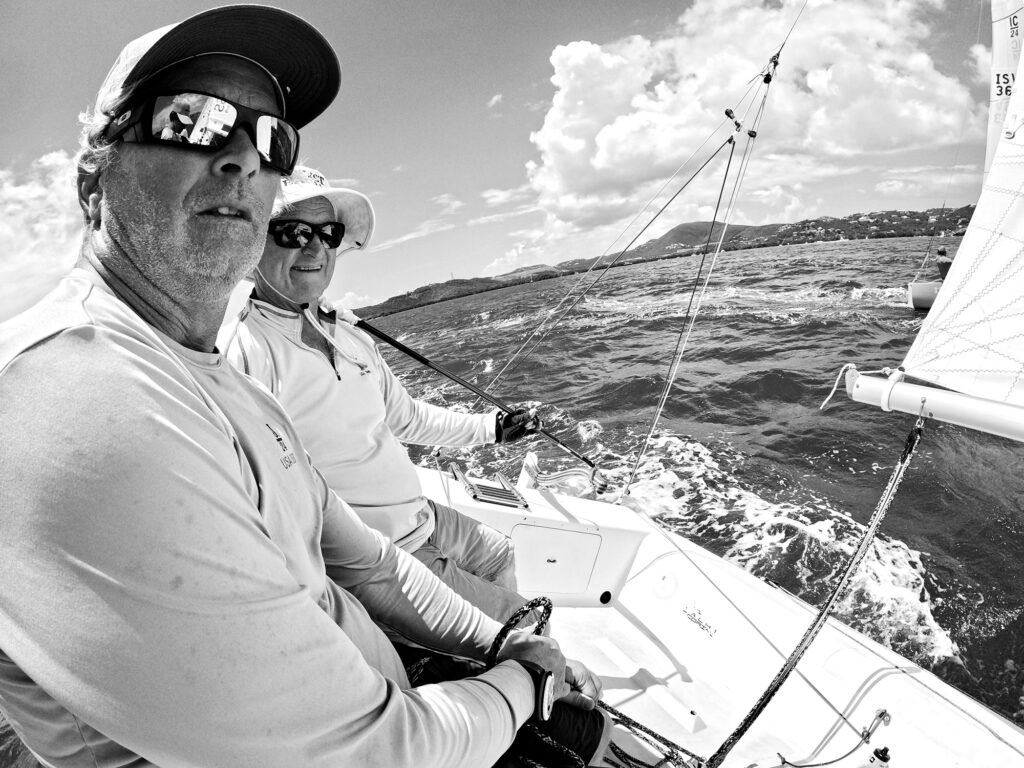
The interclub part of Rosenberg’s vision spawned the interisland IC24 phenomenon. There are now fleets in St. Croix and Puerto Rico, which is where the hot boats reside—dialed-in, dry-sailed. Across the fleet, “one-design” is “close enough” for laid-back Caribbean class racing.
But that doesn’t mean the slick-looking Puerto Rican IC24s are inherently faster than St. Thomas YC’s heavily used charter boats, which are available for STIR at a cost just north of $3,000. For that, and a $200 monthly yacht-club membership, we get unlimited use of the IC24, as well as the club’s Hobie Waves and Sunfish. With this deal, you can have one heck of a St. Thomas sailing vacation.
But it gets better. Hundreds of rentable condos flank the club, all of them with sweeping hillside views of Cowpet Bay and pristine islands in the near distance. From our four-bed condo with a balcony, for which we paid $3,000 for the week, we can walk exactly 87 steps to the club, straight to the launch, to the boat, to the racecourse and back.
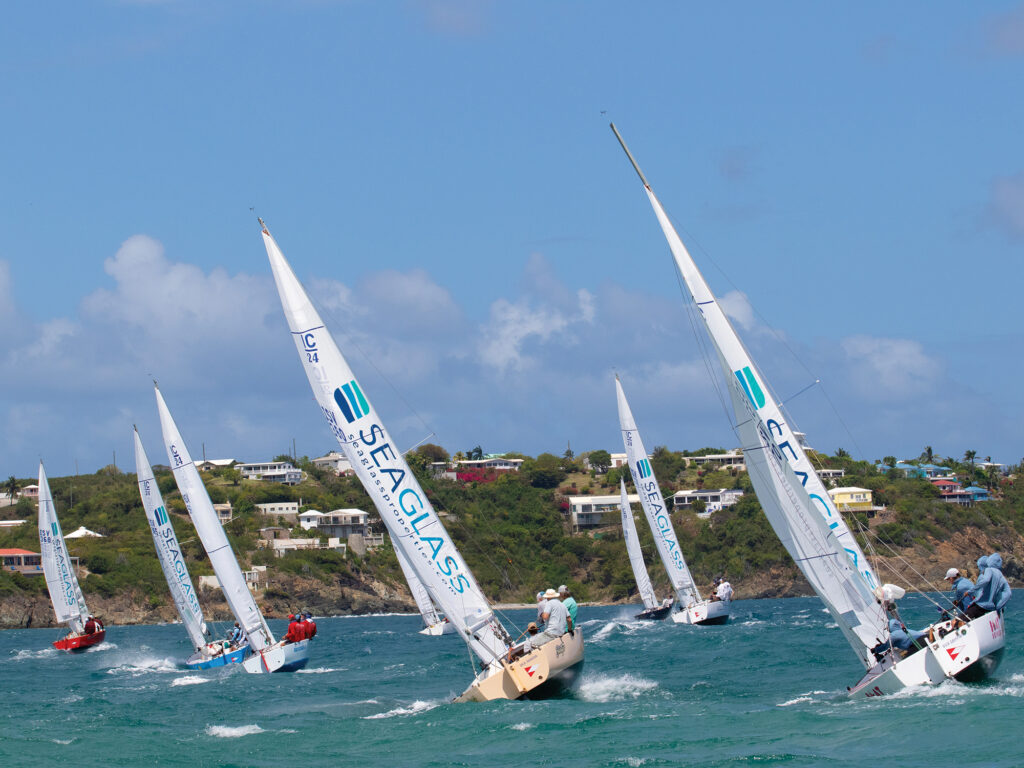
There’s no reason to cook dinner at the condo because the club’s nightly buffet spread—pasta night, barbecue night and meat night—is all you need to race, eat, drink, sleep and repeat. That’s how it flows in St. Thomas.
Relaxation Earned The Hard Way
Such is the rhythm we settle into after our first day of racing, which we toast to with balcony beers. We’re solidly midfleet. We’ve had some good races; we’ve been in the mix with the top local boats at the first mark, but we’re losing boats on the run by not jibing soon enough. Our race-committee honcho is Dick Neville, a white-haired Aussie from Annapolis who’s the king of running races in the Caribbean. Because of the record-size IC24 fleet, there’s no room for Neville to set up in Red Hook Bay, where the IC24s normally race during STIR, so we’re wedged in around the corner in Nazareth Bay.
Neville has his race-committee boat parked 50 feet or so away from the coral-pocked headland. A short finish line is set on his starboard side, even closer to solid ground. He’s kind enough to enlighten us before the start of the first race that we should jibe immediately after finishing.
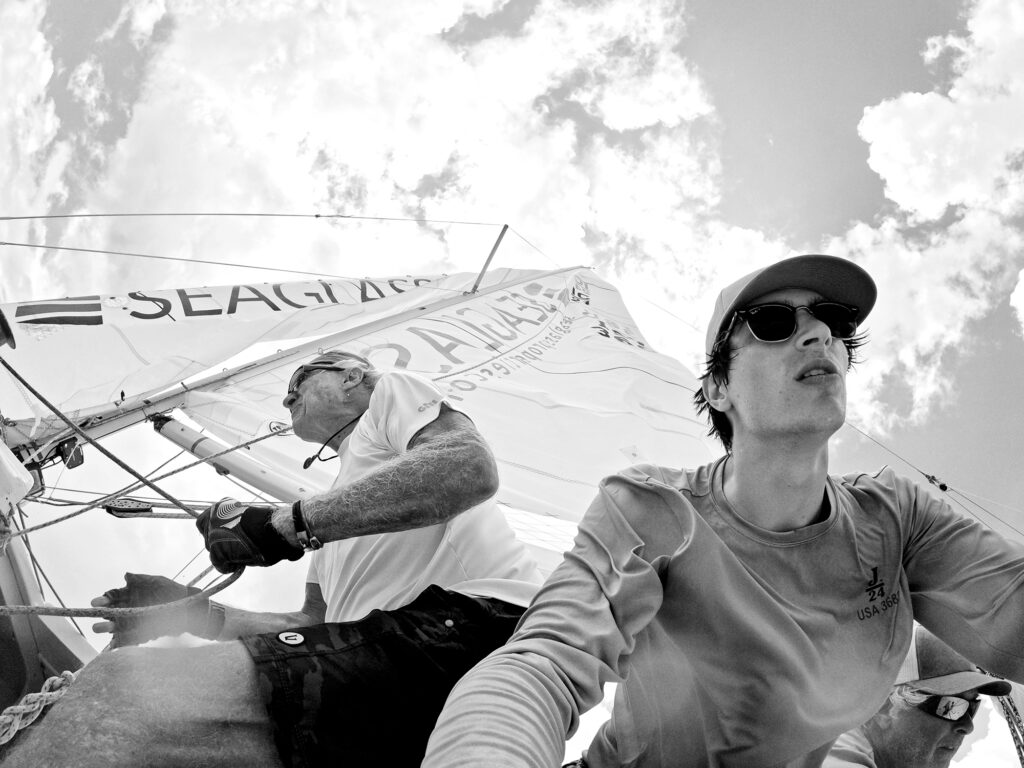
By the nature of the race committee’s parking job, Neville has favored the committee boat end, but there’s not a lot of wiggle room or runway for either a barging or Vanderbilt-style start. The one bit of local knowledge that everyone seems to know is to go left for the lift off the shore at the top of the beat, but with a 1.2-mile leg and a long line, starting at the pin end is a fast pass to the middle fleet, which is where we end up at the end of the day. The locals are crushing.
The first day’s friendly trade winds allow us to ease into the regatta, but the following morning, the palm fronds are hissing. Breeze on. Back home in New England, 25 knots often feels like a lot more. The air is colder, heavier, and punchier. In the Caribbean, 25 feels perfect: warmer, gentler, with diamond-filled puffs flitting across the blue. Don’t bother bringing foul weather gear to St. Thomas. But do bring gloves, because the salt-caked ropes carve bare-skin crevices to the bone. And pack your swim trunks for an after-race pit stop in Christmas Cove for a swim and the fresh-out-of-the-oven Easy Peasy Cheesy from Pizza Pi boat anchored in the cove.
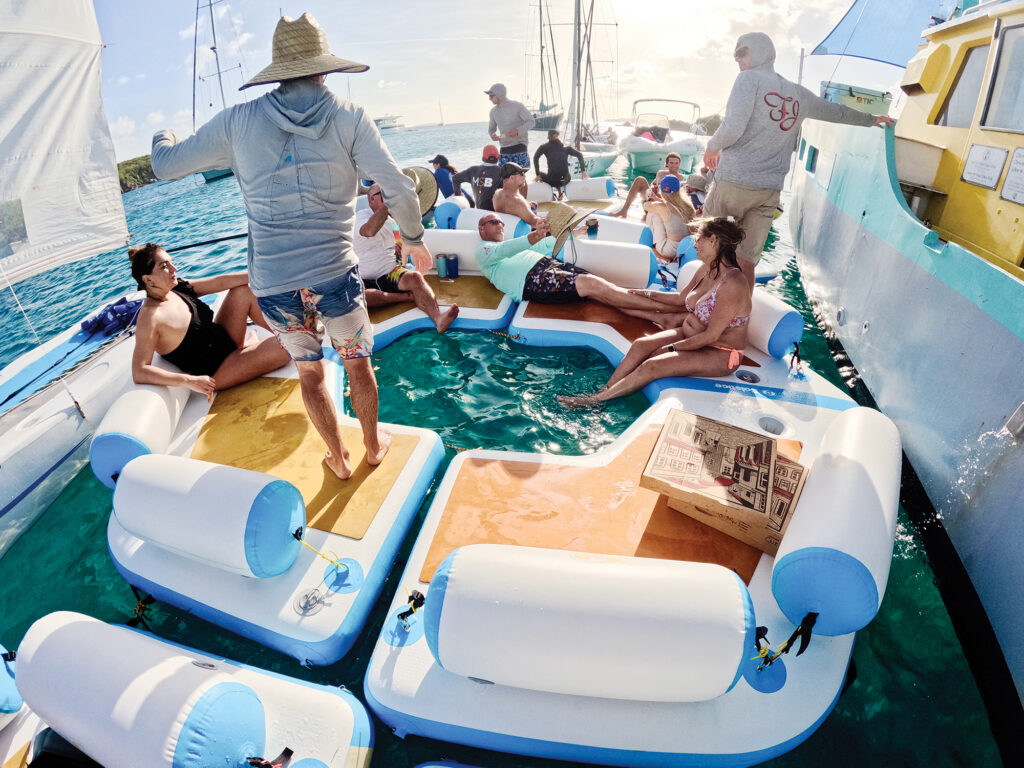
Tears, Beers and A Bully
Twenty-five knots is what we get for the next five races. Tim is an overnight sensation at remembering the mechanics of getting the spinnaker out of the hatch without snagging on the shrouds, and then back into the boat during windy and chaotic leeward-gate roundings. While he’s blissfully learning and bleeding, the rest of us are having our issues: Ian’s oversize tiller extension keeps getting caught in the backstay. Herb is on doctor’s orders to not destroy his recently rehabilitated rotator cuff again. He has no winches for the highly loaded kite sheets, and he’s playing them straight from their respective blocks. I’m constantly fighting with the spinnaker pole, which won’t stay on deck, and through the leeward gate, I’m high-stepping through and around Tim and Herb to get back in time to hand-over-hand the mainsheet through the turn.
It’s a miracle we make it through all the tacks, jibes and corners without issue.
But we’re far from perfect. At some point in the blur of Neville’s five rapid-fire races, we whiff one windy jibe and wrap the spinnaker sphincter-tight around the headstay. It’s a bummer of a mistake because we’re having our best race yet. When you’re tired and beaten, St. Thomas’ 25 suddenly feels like a New England 25. For the last race, we cry uncle and shift to jib-and-main. We’re comfortable with our place and our purpose. We’re not here to win it, and a voice of reason in my head is loud and clear: Don’t make Tim hate this.
Just one more race. Let’s make it a good one.
We’re in the mix for the first lap, but without a spinnaker, we’re eventually at the back of the fleet. Approaching the weather mark for the second time, we’re on the port-tack layline, and out in front of us, two starboard tackers easily cross our bow. Behind them is a gaping hole in front of the next boat.
What do you know? It’s Voila. Of course it is.
As soon as the shouting starts, I know where this is going. They are way overstood, their jib is eased to the rail, and the leeward telltale is pointing skyward. Clean and easy, I think to myself. No problemo.
Ian pushes the tiller away to tack, as he has a million times before, but this time, the annoying extension gets lodged in the backstay cascade. It’s not a pro tack, but it’s good enough.
“That’s a foul!” someone bellows.
“No way!” I retort.
Enraged words fly as we round the weather mark, and the shouting continues down the entire offset leg. We split jibes after the rounding, and try as we might to out wing-on-wing them, they beat us easily across the finish. Oh well. I think. We’ll get ‘em tomorrow.
Back ashore, as we saunter down the quay toward the club bar, parched, sunbaked, wind-whipped, smarting and deflated, the pink boat’s skipper, still fuming, advises me of his intent to protest the incident. Paperwork is already filed.
Our futile argument carries on and over to a waiting area outside an air-conditioned shack in the parking lot where the jury is in session. I cannot convince him of the senselessness of the exercise. He beat us, we’re both at the bottom of the standings, and we’re both sticking to our stories. Besides, the rum is flowing, and there’s a rigged Hobie Wave on the beach with my and Tim’s name on it. Christmas Cove is calling, and the sun’s going down. This isn’t the world championship, pal. What are we doing here?
Go Have a Hobie Day
Thankfully, the committee promptly disallows the protest on account of Voila failing to display a protest flag. And thanks to that glorious technicality, Tim and I are soon zippering catamaran wakes with a rapid exit out of Cowpet Bay, water splashing through the trampoline.
Once clear of the mooring field, Tim takes over, nervously holding the tiller bar and beginning his journey to sailing bliss. He’s kind of a natural, and the smile on his face as the little cat takes off is a memory forever placed into the happy-memory drawer of my mind. He gets his Pi slice, and I get him a T-shirt to memorialize this precious father-son experience.
The ol’ boys back at the condo are duly impressed by our willingness to go back out to sea in the Hobie Wave after such a physically and mentally draining race day. YOLO, indeed.
The palm fronds are sizzling again as we ramble down the steps from our condo the following morning. It’s another glorious Caribbean race day, and we’re ready for it.
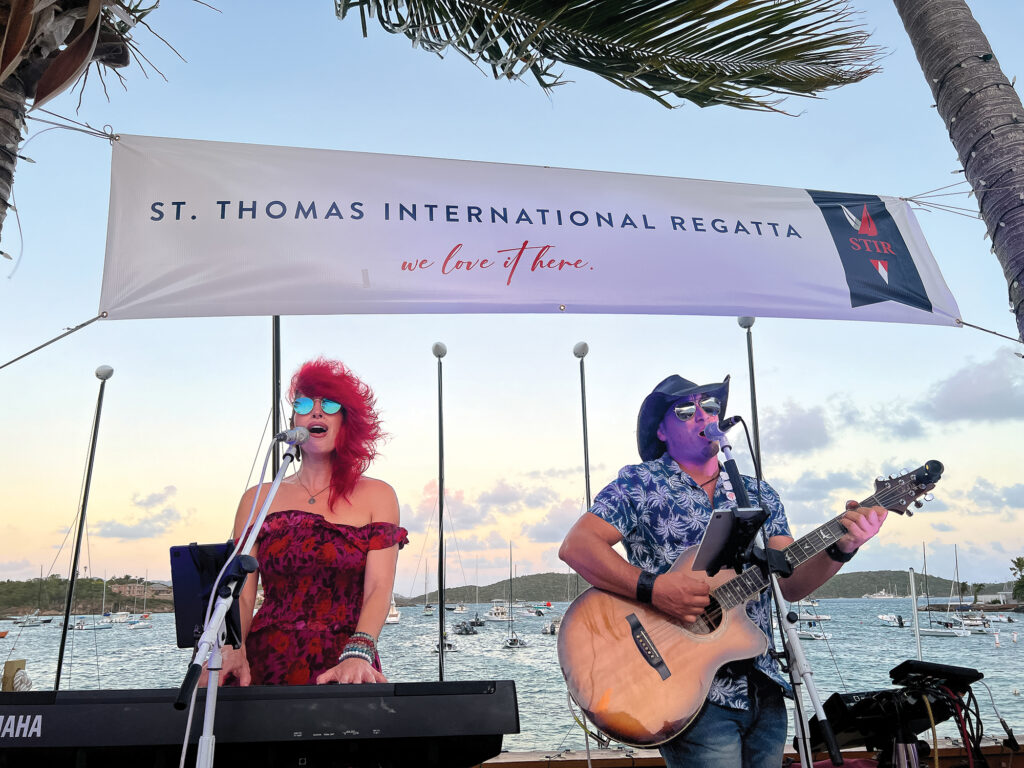
That is, until the mainsheet swivel-cam base explodes on the way out to the racecourse. Ian saves the day with a spare shackle that’s in his little plastic zipper bag of spare hardware. But as the day goes on, we’re not the only ones handicapped with breakdowns. At some point in another blur of five races, Voila blows its vang, and in the third race, our jib halyard skies to the top rig (the shackle tape job didn’t hold, I promise).
Voila and Stinger are now both playing in the jib-and-main minor league, and in the next race we’re at each other’s throats again, all around the course. On the final leg, they’ve got a jump on us, so I’m fighting the sheet and cursing at the jib, wishing for a spinnaker to make the pain in my shoulder stop. But they’re faster, have a better angle in the waves, and slip ahead halfway down the run. I’m cursing under my breath. We can’t lose to them!
Because Every Point Counts
But miracles do indeed happen, and just as it appears we will lose this battle, mere boatlengths from the finish, they spin out of control and head-to-wind, sails flogging in the wind. Behind the boat pops up its pink-shirted skipper, flailing in the water and waving the broken tiller extension in the air as his crew scrambles to stop and get him back on board.
It’s been a long time since I felt such true joy in someone else’s misfortune. But we’ll happily take that point, thank you very much.
They must have sensed my smugness, or they simply have it out for us, because in the next and final race, they seek us out in the final 30 seconds of the start, intently tacking to leeward and shouting at us to head up. As they would, they stuff us head-to-wind, driving us into a pile of boats above us.
Like, come on, man. Is that really necessary?
Our hopes of a good start, and to finish the regatta on a high note, are toast. We’re pinned against their windward quarter as we cross the line. There’s nowhere to bail out, and there’s a long starboard tack ahead of us. We’re screwed.
Until Neville mumbles a set of OCS numbers over the crackle of the VHF. Our friends are soon peeling off and heading back to the line to restart.
With an open course, the four of us collectively dig in deeper for a keeper. Through sheer persistence, we’re rewarded with our best finish. Viola is nowhere in sight the entire race.
As the saying goes, we are only as good as our last race, so that night, over the last of our Cruzan-and-Ting “Crack-O Stingers,” we groan out our aches, empty the box of adhesive bandages, and raise our glasses to the wisdom of our spring-training block—and one to our friends on Voila. Racing is nothing without our rivals, and we met ours with poise. We’ve stirred it up, all right.

